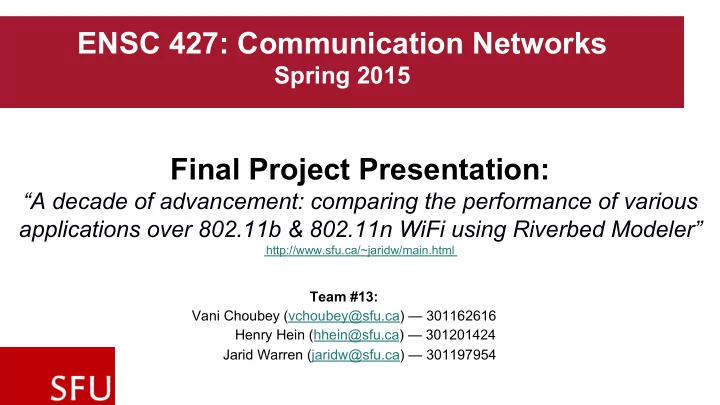

ENSC 427: Communication Networks Spring 2015 Final Project Presentation: “A decade of advancement: comparing the performance of various applications over 802.11b & 802.11n WiFi using Riverbed Modeler” http://www.sfu.ca/~jaridw/main.html Team #13: Vani Choubey (vchoubey@sfu.ca) — 301162616 Henry Hein (hhein@sfu.ca) — 301201424 Jarid Warren (jaridw@sfu.ca) — 301197954
Roadmap ➔ Introduction ➔ Related Work ➔ Riverbed Model ➔ Simulation Results ➔ Conclusions ➔ Future Work ➔ References
Introduction ● Major goal: show how far we’ve come with 802.11 (b vs. n) ● Background: ○ 802.11b introduced in 1999 up to 11 Mb/s (we used 5.5 Mb/s), infrared in 2.4 GHz, CSMA/CA MAC ○ 802.11n introduced in 2009, MIMO up to 600 Mb/s (we used 480 Mb/s), frame aggregation, security improvements and dual bands (2.4 and 5 GHz)
● Looked at average throughput & delay of 3 applications: ○ YouTube HD stream (HTTP) - 2009 ○ VoIP (RTP) - 2004 ○ FTP – 1998
Related Work Out of Dr. Trajkovic’s ENSC 427 offerings: ● Spring ‘15: H. Yu and C. Wen. “ Comparison of 802.11g and 802.11n Standards ” ● Spring ‘11 : Z. Xue. “Video Streaming over the 802.11g and the 802.11n WLAN Technologies” ● Spring ‘10 : Y. Hakki et al. “ Comparison of the Quality of Service (QoS) of the 802.11e and the 802.11g wireless LANs”
Server Riverbed Model ● San Jose subnet ● Local server support applications ● Sends info to client via backbone network
Client Riverbed Model ● Vancouver subnet ● 802.11b cell = 35m 802.11n cell = 70m ● 3 workstations 10m away from router to load network (P2P traffic) 802.11n cell shown here
● 2 fixed nodes: ○ 5m from router ○ 15m from router ● 1 mobile node ○ 7.5m from router ○ random waypoint algorithm ○ 1.4 m/s speed 802.11n cell shown here
Profile Definition
P2P Model ● Default: High Traffic Setting ● File size: 0.1 MB to 10 MB (a song)
YouTube Model ● Page Interarrival Time: 15 - 25 frames/second ● File size: ~110 kB/frame ● One object per page (Fullscreen)
VoIP Model ● G.711 64 Kbps Pulse Code Modulation standard ● Silence accounts for silence period during the conversation
File Transfer Model ● File Size: 50 KB (a pdf file)
P2P Traffic 1 Mb/s Mobile Close 1 Mb/s Far 802.11b vs. 802.11n average throughput (bit/sec)
YouTube Results 400 kb/s Mobile Close 400 kb/s Far 802.11b vs. 802.11n average throughput (bits/s)
0.75 ms Mobile Close Far 50 ms 802.11b vs. 802.11n average delay from server (s)
VoIP Results 100 kb/s Mobile Close 100 kb/s Far 802.11b vs. 802.11n average throughput (bits/s)
0.22 ms Mobile Close Far 50 ms 802.11b vs. 802.11n average delay from server (s)
File Transfer Results 1 Mb/s 1 Mb/s Mobile Close Far 802.11b vs. 802.11n average throughput (bits/s)
80 ms Mobile Close Far 80 ms 802.11b vs. 802.11n average delay from server (s)
Conclusions ● What did we expect? o 802.11n to dramatically outperform 802.11b in both average throughput and delay o Performance difference as app age § ie. 802.11b handled FTP better than YouTube o Router distance performance § mobile performance < fixed performance
● Average throughput comparison wasn’t that different considering 802.11b was set at 5.5 Mb/s vs. 480 Mb/s for 802.11n ● Delay told the true tale, differences up to 1500x/3500x for max and steady-state respectively ● Older the application, the smaller the difference
● What about the 3 different kinds of workstations? ○ Delay had minimal dependence on mobility or distance from router ■ exception: 802.11n running FTP ○ Average throughput wasn’t as clear ■ ⅔ times being further from 802.11n router helped ■ 802.11b all over the map
Future Work ● 802.11ac update to see advancement from 2009 ● WAN historical comparison analogous to LAN we did (eg. EDGE vs. LTE) ● Original plan of WiFi vs. LTE to compare performance of LAN vs. WAN
References [1] G. R. Hiertz, D. Denteneer et al., "The IEEE 802.11 Universe," Communications Magazine, IEEE, Volume: 48, Issue: 1, January 2010. Accessed: February 15, 2015. Available: http://ieeexplore.ieee.org.proxy.lib.sfu.ca/xpl/articleDetails.jsp?arnumber=5394032&tag=1 [2] "Wireless Networking," Vicomsoft. Accessed: March 22, 2015. Available: http://www.vicomsoft.com/learning-center/wireless-networking/#3 [3] L. Phifer, "Differences between WLANs, Wi-Fi and WiMax". Accessed: February 15, 2015. Available: http://searchnetworking.techtarget.com/answer/Differences-between-WLANs-Wi-Fi-and-WiMax [4] C. Chen, S. Sheng, and J. Yoo, “High Resolution Video Streaming over Wi-Fi, WiMAX and LTE,” Accessed: March 22, 2015. Available: http://www.sfu.ca/~cyc19/report.pdf [5] R. Gill, T. Farah, and L. Trajkovic, “Comparison of WiMAX and ADSL Performance when Streaming Audio and Video Content,” Accessed: March 22, 2015. Available: http://www2.ensc.sfu.ca/~ljilja/papers/Opnetwork2011_farah_gill_final.pdf [6] Riverbed Modeler’s Guide to Applications. Accessed: March 22, 2015. Available: https://webdav.sfu.ca/ web/ensc/427/1151/group13/site/Reference9.pdf
Questions?
Recommend
More recommend